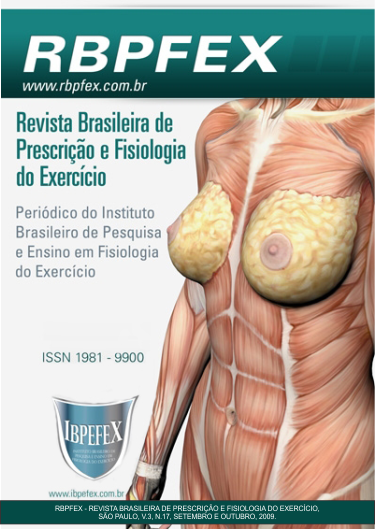Changes in blood pressure and heart rate in a class of women in dance Samkya normotensive
Abstract
The objective of the present study was to demonstrate the alterations of the PA (BP – Blood Pressure) and FC (HR – Heart Rate) in women aged between 18 and 68 years old, all beginners in the Sankya dance in a gym in Curitiba/ PR. The study population comprises N= 8 women beginners in Sankya dance, they practiced 60’ of Sankya dance with intensity from light to moderate followed by stretching and relaxation. The FC and HR were measured in rest, at 5’, 10’ and 30’ after the exercise. Results: The FC and the PA, have shown a tendency for decreasing from the pre to the 30’ post exercise, although none of them have shown meaningful alteration. Through the crossing between pre until the 30’, the Anova test from Friedman, has shown that there are no meaningful differences between the groups of variable PAS (p = 0.44) and PAD (p = 0.59) and FC (0.28). The post exercise hypotension endured throughout the whole recovering period. Via the correlation linear test of Pearson, all variables are associated amongst themselves, the PAS is statistically associated to PAS (r = 0.69, p = 0.00) and FC (r = 0.67, p = 0.00) and vice versa. One can conclude tat the class of Sankya dance should be applied with more intensity and volume, with reduced intervals to promote more meaningful hypotension effect, for results have shown a tendency towards the decreasing of FC and PA, although not a significant one.
References
- Araújo, C.G.S. Fisiologia do exercício físico e hipertensão arterial. Uma breve introdução. Revista Hipertensão. Vol. 4. Num.3. 2001. p. 30-35.
- Brum, P.C.; e colaboradores. Adaptações agudas e crônicas do exercício físico no sistema cardiovascular. Revista. Paulista de. Educação. Física, São Paulo. Vol.18. Num 31. 2004. p.21-31.
- Barros e colaboradores. O exercício. Preparação fisiológica, avaliação médica, aspectos especiais e preventivos. São Paulo: Atheneu, 1999; p.3-13.
- Carmo e colaboradores. Monitorização da Pressão Arterial Sistêmica no Efeito Agudo Imediato e Tardio do Exercício Resistido Moderado num Individuo Hipertenso Leve. Revista Brasileira de prescrição e Fisiologia do Exercício, São Paulo. Vol.1. Num. 6. 2007. p. 28-38.
- Caminada, E. História da Dança: Evolução Cultural. Rio de Janeiro: Sprint, 1999.
- Delbim, M.A.; Moraes, C.; Zanesco, A. Efeito do exercício por dança na pressão arterial de mulheres hipertensas. Revista Brasileira de Hipertensão. Vol.11. Num. 4. 2008. p. 267-269.
- Forjaz, C.L.M.; e colaboradores. Exercício resistido para o paciente hipertenso: indicação ou contra-indicação. Revista Brasileira de Hipertensão, Ribeirão Preto, Vol. 10. Num. 2. 2003. p. 119-124.
- Forjaz, C.L.M.; e colaboradores. A duração do exercício determina a magnitude e a duração da hipotensão pós-exercício. Arquivos Brasileiros de Cardiologia, São Paulo. Vol. 70. Num. 2. 1998. p. 99-104.
- Gonçalves, I.O.; Silva, Gustavo, J.J.; Navarro, A.C. Efeito Hipotensivo do exercício físico aeróbico agudo em idosos hipertensos entre 60 e 80 anos. Revista Brasileira de prescrição e Fisiologia do Exercício, São Paulo. Vol.1. Num. 5. 2007. p. 76-86.
- Irigoyen e colaboradores. Exercício físico no diabetes melito associado à hipertensão arterial sistêmica. Revista Brasileira de Hipertensão. Vol. 10. 2003. p.109-117.
- Laban, R. O Domínio do Movimento. São Paulo: Summus, 1978.
- Laban, R. Dança educativa moderna. São Paulo: Ícone, 1990.
- Liberali, R. Metodologia Científica Prática: um saber-fazer competente da saúde à educação. Florianópolis: (s.n.), 2008.
- Monteiro e colaboradores. Efetividade de um programa de exercícios no condicionamento físico, perfil metabólico e pressão arterial de pacientes hipertensos. Revista Brasileira de Medicina e Esporte. Vol.13. Num. 2. 2007. p. 29-35.
- Pássaro, L.C.; Godoy, M. Reabilitação cardiovascular na hipertensão arterial. Revista da Sociedade de Cardiologia do Estado de São Paulo. Vol.6. Num.1. 1996. p. 45-58.
- Pinheiro e colaboradores. Uso do ioga como recurso não-farmacológico no tratamento da hipertensão arterial essencial. Revista Brasileira de Hipertensão. Vol.14. Num. 4. 2007. p.226-232.
- Rondon, M.U.P.B.; Brum, P.C. Exercício físico como tratamento não-farmacológico da hipertensão arterial. Revista Brasileira de Hipertensão, Ribeirão Preto. Vol.10. 2003. p. 134-139.
- Samkya, Disponível em: www.sankya.com.br/. Acesso em Fev, 2009.
- Silverthorn, D.U. Fisiologia integrada. Fisiologia humana. Uma abordagem integrada. 2.ed. Barueri (SP): Manole, 2003.
- Sociedade Brasileira de Hipertensão. Departamento de Hipertensão da Sociedade Brasileira de Cardiologia. Departamento de Hipertensão da Sociedade Brasileira de Nefrologia III diretrizes para uso da monitorização ambulatorial da pressão arterial, [s/l], Revista Brasileira de Hipertensão. Vol. 8. Num.1. 2001. p. 143-153.
- Takatsuji, e colaboradores. Valores da pressão arterial e da frequência cardíaca, após 18 meses de atividade física. Revista Digital - Buenos Aires – Ano 9. Num. 66. Nov, 2003.
- Weineck, J. Fatores de risco das doenças degenerativas do coração e circulação: Prevenção e Reabilitação. In Weineck, J. Biologia do Esporte: São Paulo. Manole. 2000. p. 378 – 412.
- I CONSENSO NACIONAL DE REABILITAÇÃO CARDIOVASCULAR. Arquivo Brasileiro Cardiologia. Vol. 69. Num. 4. 1997.
Authors who publish in this journal agree to the following terms:
- Authors retain the copyright and grant the journal the right of first publication, with work simultaneously licensed under the Creative Commons Attribution License BY-NC which allows the sharing of the work with acknowledgment of the authorship of the work and initial publication in this journal.
- Authors are authorized to enter into additional contracts separately for non-exclusive distribution of the version of the work published in this journal (eg, publishing in institutional repository or book chapter), with acknowledgment of authorship and initial publication in this journal.
- Authors are allowed and encouraged to post and distribute their work online (eg, in institutional repositories or on their personal page) at any point before or during the editorial process, as this can bring about productive change as well as increase impact and impact. citation of published work (See The Effect of Free Access).






